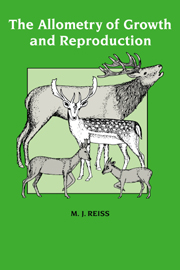Book contents
- Frontmatter
- Contents
- Preface
- 1 Introduction
- 2 The scaling of average daily metabolic rate and energy intake
- 3 Why do larger species invest relatively less in their offspring?
- 4 The intraspecific relationship of parental investment to female body weight
- 5 Growth and productivity
- 6 Quantitative models of body size
- 7 Sexual dimorphism in body size
- 8 Are larger species more dimorphic in body size?
- 9 Surface area/volume arguments in biology
- 10 Prospectus
- Glossary of mathematical terms
- References
- Index
7 - Sexual dimorphism in body size
Published online by Cambridge University Press: 02 December 2009
- Frontmatter
- Contents
- Preface
- 1 Introduction
- 2 The scaling of average daily metabolic rate and energy intake
- 3 Why do larger species invest relatively less in their offspring?
- 4 The intraspecific relationship of parental investment to female body weight
- 5 Growth and productivity
- 6 Quantitative models of body size
- 7 Sexual dimorphism in body size
- 8 Are larger species more dimorphic in body size?
- 9 Surface area/volume arguments in biology
- 10 Prospectus
- Glossary of mathematical terms
- References
- Index
Summary
Many authors, dating back to Darwin (1871), have considered factors that might affect the degree of sexual dimorphism (reviewed by Clutton-Brock, Harvey & Rudder, 1977; Mace, 1979). Frequently, however, only one sex is considered, or it is unclear what limits the degree of sexual dimorphism. For example, intermale conflict is believed to select for increased male size (Darwin, 1871; Selander, 1972; Trivers, 1972). However, larger females achieve greater reproductive success (Chapter 4) and Rails (1976a) has argued that this may be why females are sometimes larger than males. On the other hand, Erlinge (1979) and Moors (1980) have argued that smaller females enjoy a bioenergetic advantage.
It is not yet clear what sets an upper limit to male size in species where males compete over females, and larger males enjoy a competitive advantage. One possibility is male-biased mortality. In many species where males are the larger sex, mortality is greater for males than for females (Potts, 1970; Selander, 1972; Clutton-Brock & Albon, 1982). Selander (1972) argued that the greater mortality of male great-tailed grackles, Quiscalus mexicanus, occurs partly because males are more vulnerable to predators, and partly because males are above the optimal size for efficient foraging. Another possibility, suggested by Belovsky (1978) and Searcy (1979), is that larger males have less energy available for reproduction.
The greatest degree of sexual dimorphism, in species where males are heavier than females, occurs in pinnipeds (Scheffer & Wilke, 1953; Bryden, 1969). Bartholomew (1970) suggested three factors which might set an upper limit on male size in pinnipeds. First, larger males are more aggressive and in the most dimorphic species oblivious of the pups, so that many pups are squashed to death.
- Type
- Chapter
- Information
- The Allometry of Growth and Reproduction , pp. 91 - 116Publisher: Cambridge University PressPrint publication year: 1989
- 1
- Cited by



